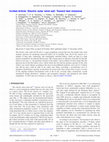Papers by Sini Merikallio

Dust settling on the martian surface poses severe problems on usage of the solar photovoltaic pow... more Dust settling on the martian surface poses severe problems on usage of the solar photovoltaic power. Settling processes are here approached from the modelling point of view. Extinction of the solar radiation in the dust layer is modelled to give the radiation intensity on the surface. Theory section focuses on the physics of sedimentation, settling, and lift-off. Turbulence and radiation propagation through the dust layer are also considered. Based on these theories, a computer model is developed, and its results are compared with real experimental data from the past Mars missions. This comparison is done in collaboration with a team from JPL/NASA. The solar panel efficiency measurements as a function of time are acquired from the NASA Pathfinder mission. At around twenty sols the measured data shows a change in the rate of decay of the solar panel system efficiency. In the absence of accurate dust deposition theories, empirical models are used and fitted to this data. Sets of model...
The first of the ESA's SMART missions (Small Missions for Advanced Research in Technology), SMART... more The first of the ESA's SMART missions (Small Missions for Advanced Research in Technology), SMART-1, is a small lunar orbiter devoted to the demonstration of innovative and key technologies for scientific deep space missions. A highly innovative and low budget mission to explore the Moon, SMART-1 was launched on the 27 th of September 2003 as an Ariane 5 cyclade-like auxiliary payload and uses a Hall thrusters (PPS1350) built by SNECMA. On 13 November 2004, Smart-1 reached the Moon capture point, 60000 km from the lunar surface. The amount of propellant required to transfer the spacecraft from GTO (650 km perigee and 35880 km apogee) to a Moon orbit (300 km over the lunar south pole and 3000 km over the lunar north pole) has been of 75 kg of Xenon. The life of SMART-1 has been extended 1 year until mid 2006. SMART-1
This is the bi-annual report of Finnish Space Research to the Committee on Space Research (COSPAR... more This is the bi-annual report of Finnish Space Research to the Committee on Space Research (COSPAR) prepared jointly by the Finnish National Committee of COSPAR and Tekes (Finnish Funding Agency for Technology and Innovation). The report describes the overall structure of Finnish space activities, the presently applied strategy, and main funding sources. The major space programmes are briefly listed. The main body of the report describes the progress during 2006-2007 in pure and applied space sciences within the domain of COSPAR activities.
http://meetingorganizer.copernicus.org/EPSC-DPS2011/EPSC-DPS2011-1564.pdf

This is the bi-annual report of Finnish Space Research to the Committee on Space Research (COSPAR... more This is the bi-annual report of Finnish Space Research to the Committee on Space Research (COSPAR) prepared jointly by the Finnish National Committee of COSPAR and Tekes (Finnish Funding Agency for Technology and Innovation). The report describes the overall structure of Finnish space activities and the progress during 2008–2009 in pure and applied space sciences within the domain of COSPAR activities. One of the highlights of Finnish space science during 2008–2009 was the launch of the Herschel and Planck satellites of ESA on May 14, 2009. The main mirror of Herschel was polished by a Finnish company and Planck carried a number of Finnish radiometers to measure the cosmic microwave background. Another spacecraft involving scientific hardware contribution from Finland was the Lunar mission Chandrayaan-1 of India with a Finnish solar X-ray instrument onboard. The satellite was launched on October 22, 2008, and continued observations until August 2009. Finland also contributed to two ...

Electrostatic plasma brake is a novel tether-based de-orbiting concept especially suitable for sa... more Electrostatic plasma brake is a novel tether-based de-orbiting concept especially suitable for satellites with less than 100 kg of mass. It is a spin-off of the Electric Solar Wind Sail (E-sail), invented in 2006 (www.electric-sailing.fi) and consisting of charged tethers transforming solar wind momentum into spacecraft acceleration through Coulomb repulsion. Also the plasma brake consists of a charged tether by which a drag with the surrounding stationary ionosphere is created. Unlike the well-known electrodynamic tether, the plasma brake tether only needs to carry the thermal current resulting from it remaining charged and can thus be made of very thin metal wires of some tens of microns in diameter. This reduces the mass and power consumption of the system relative to the electrodynamic tether. The tether is also thin enough that if it breaks, the broken piece does not threaten other satellites and will also deorbit quickly by its low ballistic coefficient. A cube-sat could be th...

This is the bi-annual report of Finnish Space Research to the Committee on Space Research (COSPAR... more This is the bi-annual report of Finnish Space Research to the Committee on Space Research (COSPAR) prepared by the Finnish National Committee of COSPAR and Finnish Funding Agency for Technology and Innovation (Tekes). The report describes the overall structure of the Finnish space activities, introduces the research organizations participating in space activities at various fronts, and gives highlights of the scientific, applied, and technological developments during the 2010 - 2011 period. The European Union 7th Framework Programme (FP7) opened for the first time a series of calls focused in particular to space activities in multiple fronts. Following a highly successful application round, Finnish space research received a significant boost when the projects started in the fields of space research, Earth observation, space weather applications, technology and research infrastructure development. All projects are carried out in wide international collaboration, which has further str...
Talk given in the Scientific Round Table of the COSPAR 2014 - Exoplanet Exploration and the Futur... more Talk given in the Scientific Round Table of the COSPAR 2014 - Exoplanet Exploration and the Future of Space Propulsion. Other participants of the round table were: Giovanni Bignami, Giancarlo Genta, Leonid Ksanfomality and Roberto Ragazzoni.
will land on the surface of a comet 67P/Churyumov-Gerasimenko. Several of Philaes instruments hav... more will land on the surface of a comet 67P/Churyumov-Gerasimenko. Several of Philaes instruments have Finnish involvement. picture by ESA.

Journal of Geophysical Research: Atmospheres, 2015
The single-scattering properties of volcanic ash particles are modeled here by using ellipsoidal ... more The single-scattering properties of volcanic ash particles are modeled here by using ellipsoidal shapes. Ellipsoids are expected to improve the accuracy of the retrieval of aerosol properties using remote sensing techniques, which are currently often based on oversimplified assumptions of spherical ash particles. Measurements of the single-scattering optical properties of ash particles from several volcanoes across the globe, including previously unpublished measurements from the Eyjafjallajökull and Puyehue volcanoes, are used to assess the performance of the ellipsoidal particle models. These comparisons between the measurements and the ellipsoidal particle model include consideration of the whole scattering matrix, as well as sensitivity studies on the point of view of the Advanced Along Track Scanning Radiometer (AATSR) instrument. AATSR, which flew on the ENVISAT satellite, offers two viewing directions but no information on polarization, so usually only the phase function is relevant for interpreting its measurements. As expected, ensembles of ellipsoids are able to reproduce the observed scattering matrix more faithfully than spheres. Performance of ellipsoid ensembles depends on the distribution of particle shapes, which we tried to optimize. No single specific shape distribution could be found that would perform superiorly in all situations, but all of the best-fit ellipsoidal distributions, as well as the additionally tested equiprobable distribution, improved greatly over the performance of spheres. We conclude that an equiprobable shape distribution of ellipsoidal model particles is a relatively good, yet enticingly simple, approach for modeling volcanic ash single-scattering optical properties.

Journal of Geophysical Research: Planets, 2014
The Mars Science laboratory (MSL) made a successful landing at Gale crater early August 2012. MSL... more The Mars Science laboratory (MSL) made a successful landing at Gale crater early August 2012. MSL has an environmental instrument package called the Rover Environmental Monitoring Station (REMS) as a part of its scientific payload. REMS comprises instrumentation for the observation of atmospheric pressure, temperature of the air, ground temperature, wind speed and direction, relative humidity (REMS-H), and UV measurements. We concentrate on describing the REMS-H measurement performance and initial observations during the first 100 MSL sols as well as constraining the REMS-H results by comparing them with earlier observations and modelling results. The REMS-H device is based on polymeric capacitive humidity sensors developed by Vaisala Inc. and it makes use of transducer electronics section placed in the vicinity of the three (3) humidity sensor heads. The humidity device is mounted on the REMS boom providing ventilation with the ambient atmosphere through a filter protecting the device from airborne dust. The final relative humidity results appear to be convincing and are aligned with earlier indirect observations of the total atmospheric precipitable water content. The water mixing ratio in the atmospheric surface layer appears to vary between 30 and 75 ppm. When assuming uniform mixing, the precipitable water content of the atmosphere is ranging from a few to 6 precipitable micrometers.

Journal of Geophysical Research-Planets, 2014
ABSTRACT 1] REMS-P, the pressure measurement subsystem of the Mars Science Laboratory (MSL) Rover... more ABSTRACT 1] REMS-P, the pressure measurement subsystem of the Mars Science Laboratory (MSL) Rover Environmental Measurement Station (REMS), is performing accurate observations of the Martian atmospheric surface pressure. It has demonstrated high data quality and good temporal coverage, carrying out the first in situ pressure observations in the Martian equatorial regions. We describe the REMS-P initial results by MSL mission sol 100 including the instrument performance and data quality and illustrate some initial interpretations of the observed features. The observations show both expected and new phenomena at various spatial and temporal scales, e.g., the gradually increasing pressure due to the advancing Martian season signals from the diurnal tides as well as various local atmospheric phenomena and thermal vortices. Among the unexpected new phenomena discovered in the pressure data are a small regular pressure drop at every sol and pressure oscillations occurring in the early evening. We look forward to continued high-quality observations by REMS-P, extending the data set to reveal characteristics of seasonal variations and improved insights into regional and local phenomena.

Review of Scientific Instruments, 2010
The electric solar wind sail ͑E-sail͒ is a space propulsion concept that uses the natural solar w... more The electric solar wind sail ͑E-sail͒ is a space propulsion concept that uses the natural solar wind dynamic pressure for producing spacecraft thrust. In its baseline form, the E-sail consists of a number of long, thin, conducting, and centrifugally stretched tethers, which are kept in a high positive potential by an onboard electron gun. The concept gains its efficiency from the fact that the effective sail area, i.e., the potential structure of the tethers, can be millions of times larger than the physical area of the thin tethers wires, which offsets the fact that the dynamic pressure of the solar wind is very weak. Indeed, according to the most recent published estimates, an E-sail of 1 N thrust and 100 kg mass could be built in the rather near future, providing a revolutionary level of propulsive performance ͑specific acceleration͒ for travel in the solar system. Here we give a review of the ongoing technical development work of the E-sail, covering tether construction, overall mechanical design alternatives, guidance and navigation strategies, and dynamical and orbital simulations.

The electric solar wind sail (E-sail) is a space propulsion concept which uses the natural solar ... more The electric solar wind sail (E-sail) is a space propulsion concept which uses the natural solar wind dynamic pressure for producing spacecraft thrust. In its baseline form the Esail consists of a number of long, thin, conducting and centrifugally stretched tethers which are kept in a high positive potential by an onboard electron gun. The methods gains its efficiency from the fact that the effective sail area of the tethers can be millions of times larger than the physical area of the thin tethers wires which offsets the fact that the dynamic pressure of the solar wind is very weak. Indeed, according to the most recent published estimates, an E-sail of 1 N thrust and 100 kg mass could be built in rather near future, providing a revolutionary level of propulsive performance (specific acceleration) for travel in the solar system. Here we give an overview and status report of the ongoing technical development work of the E-sail, covering tether construction, overall mechanical design alternatives, guidance and navigation strategies and dynamical and orbital simulations.









Uploads
Papers by Sini Merikallio